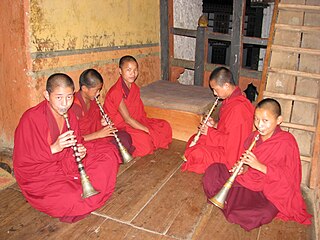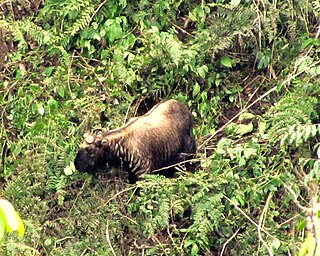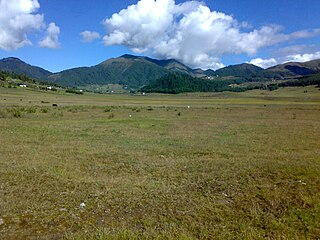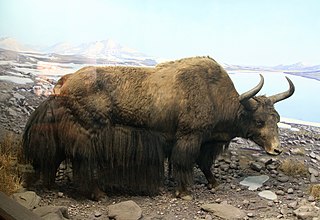This article's tone or style may not reflect the encyclopedic tone used on Wikipedia.(May 2023) |
Ap Chuni Dorji is a Bhutanese poet and creator of the song "Yak Legpai Lhadar Gawo". [1]
This article's tone or style may not reflect the encyclopedic tone used on Wikipedia.(May 2023) |
Ap Chuni Dorji is a Bhutanese poet and creator of the song "Yak Legpai Lhadar Gawo". [1]
The song is about a handsome yak (Legpai Lhadar Gawo) who was ordered to be taken from his beloved herder and slaughtered for meat. Over the years, however, the lyrics and meaning of the song have been shortened and often reworded. [2]
An English translation of Dorji's yak song:
"How beautiful is Yak Legpai Lhadar’s face!
Yak Legpai Lhadar – the god-sent calf!
There is no need to describe my place and paths,
If I were to explain my place and paths,
It is on the high snow-capped mountains
And the highland meadow of sershog flower
Where flower buds blossom. There, my home is.
I graze on mountains grass,
And drink fresh water of glacial lakes.
Should I dance my happiness,
I dance along the base of distant meadows.
One by one, the whole herd was slaughtered!
And I, the unfortunate Lhadar
It is I, Lhadar who feel sad.
A heavy command of a powerful lord came,
A man with a sword fastened at his waist
Came to take me, Lhadar.
Lhadar has no choice not to go.
When turn to be slaughtered is set
The turn fell on me, Lhadar.
Crossing mountains, a Highlander came.
And when the Highlander came,
The snow-covered peaks above, how high?
And Lhadar’s tree of life, how low?" [3]

Haa District is one of the 20 dzongkhag or districts comprising Bhutan. An alternative name for the district is "Hidden-Land Rice Valley." It the second least-populated dzongkhag in the country after Gasa.

The music of Bhutan is an integral part of its culture and plays a leading role in transmitting social values. Traditional Bhutanese music includes a spectrum of subgenres, ranging from folk to religious song and music. Some genres of traditional Bhutanese music intertwine vocals, instrumentation, and theatre and dance, while others are mainly vocal or instrumental. The much older traditional genres are distinguished from modern popular music such as rigsar.

"The Chimney Sweeper" is the title of a poem by William Blake, published in two parts in Songs of Innocence in 1789 and Songs of Experience in 1794. The poem "The Chimney Sweeper" is set against the dark background of child labour that was prominent in England in the late 18th and 19th centuries. At the age of four and five, boys were sold to clean chimneys, due to their small size. These children were oppressed and had a diminutive existence that was socially accepted at the time. Children in this field of work were often unfed and poorly clothed. In most cases, these children died from either falling through the chimneys or from lung damage and other horrible diseases from breathing in the soot. In the earlier poem, a young chimney sweeper recounts a dream by one of his fellows, in which an angel rescues the boys from coffins and takes them to a sunny meadow; in the later poem, an apparently adult speaker encounters a child chimney sweeper abandoned in the snow while his parents are at church or possibly even suffered death where church is referring to being with God.

Bhutan, officially the Kingdom of Bhutan, is a landlocked country in South Asia situated in the Eastern Himalayas between China in the north and India in the south. With a population of over 727,145 and a territory of 38,394 square kilometres (14,824 sq mi), Bhutan ranks 133rd in land area and 160th in population. Bhutan is a constitutional monarchy with a king as the head of state and a prime minister as the head of government. Vajrayana Buddhism is the state religion and the Je Khenpo is the head of the state religion.

The Kangshung Face or East Face is the eastern-facing side of Mount Everest, one of the Tibetan sides of the mountain. It is 3,350 metres (11,000 ft) from its base on the Kangshung Glacier to the summit. It is a broad face, topped on the right by the upper Northeast Ridge, and on the left by the Southeast Ridge and the South Col. Most of the upper part of the face is composed of hanging glaciers, while the lower part consists of steep rock buttresses with couloirs between them. The steep southern third of the Kangshung Face also comprises the Northeastern Face of Lhotse; this section may be considered a separate face altogether following the division of the South "Neverest" Buttress up to the South Col. It is considered a dangerous route of ascent, compared to the standard North Col and South Col routes, and it is the most remote face of the mountain, with a longer approach.

Ten Bulls or Ten Ox Herding Pictures is a series of short poems and accompanying drawings used in the Zen tradition to describe the stages of a practitioner's progress toward awakening, and their subsequent return to society to enact wisdom and compassion.

Gasa is a town near Gasa Dzong in Gasa District in northwestern Bhutan.

The Bhutan Takin is a subspecies of Takin native to Bhutan but also found in North Eastern India, Western part of China, and Tibet. Locally known as drong gimtse, it holds the honor of being Bhutan's national animal.
The Khengkha language, or Kheng, is an East Bodish language spoken by ~40,000 native speakers worldwide, in the Zhemgang, Trongsa, and Mongar districts of south–central Bhutan.
Gongduk or Gongdu is an endangered Sino-Tibetan language spoken by about 1,000 people in a few inaccessible villages located near the Kuri Chhu river in the Gongdue Gewog of Mongar District in eastern Bhutan. The names of the villages are Bala, Dagsa, Damkhar, Pam, Pangthang, and Yangbari (Ethnologue).

The Phobjikha Valleyཕོབ་སྦྱིས་ཁ spelled as Pho-sbis-kha, is a vast U-shaped valley in central Bhutan. The valley houses one of the impressive ancient Buddhist monasteries in Bhutan known as Gangteng Monastery of the Nyingma sect in central Bhutan. The graceful black-necked cranes in Bhutan from the Tibetan Plateau visit the valley during the winter season to roost. On arrival in the Phobjikha Valley in the last week of October, the black-necked cranes circle the Gangteng Monastery three times and also repeat the process while returning to Tibet.
Bji Gewog is a gewog of Haa District, Bhutan. It is the northernmost gewog of the Haa District, bordering China's Chumbi Valley. The gewog has mostly mountainous terrain, with rivers flowing into Amo Chu in the west and the Ha Chu in the east. China claims a large part of the gewog as its territory and has recently started building roads and villages in the border areas.

Jigme Singye Wangchuck National Park covers an area of 1,730 square kilometres (670 sq mi) in central Bhutan. It protects a large area of the Black Mountains, a sub−range of the Himalayan Range System.

The wild yak is a large, wild bovine native to the Himalayas. It is the ancestor of the domestic yak.

The Dochu La( Dochu Pass, la means pass in Dzongkha) is a mountain pass in the snow covered Himalayas within Bhutan on the road from Thimphu to Punakha where 108 memorial chortens or stupas known as "Druk Wangyal Chortens" have been built by Ashi Dorji Wangmo Wangchuk, the eldest Queen Mother. Apart from the chortens there is a monastery called the Druk Wangyal Lhakhang (temple), built in honour of the fourth Druk Gyalpo, Jigme Singye Wangchuck; the open grounds in its front yard is a venue for the annual Dochula Druk Wangyel Festival. The pass with 108 memorial chortens is adjacent to the country's first Royal Botanical Park.
Kezang Dorji is a Bhutanese rapper, social worker, and a youth icon. He was named "The Rising Star of Bhutan" in 2016 by Kuensel. He is also the recipient of the prestigious South Asian Youth Award 2018. Kezang is the first Bhutanese artist to be featured on BBC News (2018) and CNN.

The Snowman Trek is the longest hiking trail of Bhutan that extends from Laya to the high Bhutanese Himalayas, covering up the northern part of the Kingdom. It was created by the yak herders of the country.
Chencho Dorji is a Bhutanese association football manager, who last worked with the Indian club Sudeva Delhi FC in the I-League 2. Besides Bhutan, he has managed in India.

Lunana: A Yak in the Classroom is a 2019 Bhutanese drama film directed by Pawo Choyning Dorji in his feature directorial debut. The film had its world premiere at the BFI London Film Festival. It was a nominee for Best International Feature Film at the 94th Academy Awards.

Pawo Choyning DorjiDruk Thuksey is a Bhutanese filmmaker and photographer. His feature directorial debut Lunana: A Yak in the Classroom (2019) was nominated for Best International Feature Film at the 94th Academy Awards. His second film The Monk and the Gun (2023) was shortlisted for the Best International Feature Film for the 96th Academy Awards.
{{cite web}}: CS1 maint: archived copy as title (link)